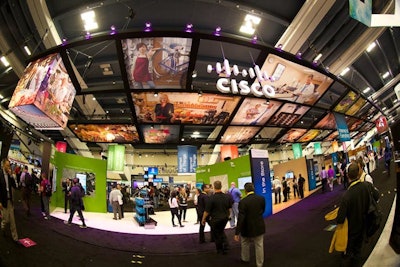
Events no longer take place within four walls. Social media and mobile platforms have eliminated those barriers, creating opportunities for brands to engage their audiences before, during, and after a physical event. At Cisco Live, May 18 to 22 at the Moscone Center, organizers convened a group of nearly two dozen “influencers,” people who are actively engaged in online communications and focus on topics such as technology, marketing, and social media strategy. The purpose was twofold: to position Cisco Live as a leader in event marketing by allowing these influential leaders in “new media” to experience—and share—the event, and also to gather input from them regarding best practices in their areas of expertise. Here are some of the tips and trends they shared about strategies for marketing and social media.
“A lot of organizations are going all social these days and forgetting about some traditional marketing mixes to really connect and engage with audiences. I talked to one C.E.O. who said, 'I’m responding more now to old-school direct mail that has some personalized approach to it than I am to most of the social requests I get, because I’m getting spammed on social and not getting anything direct mail.' So you need to have a healthy mix. And then lastly is really being audience-centric. If you can let go of what your needs, wants, and desires are and focus on what your audience's needs, wants, and desires are, you can create great experiential events, you can create great social media campaigns, you can tie the two together, and you can create a really engaging strategy. The term I’ve been tossing around is ‘delight and let go.’ Because most marketers don’t want to do that. They want to control and hold on to it and make it their own, and that loses what you are trying to do for your audience.”
—Todd Wilms, head of social business strategy, SAP
“A lot brands are filling their networks with noise and noise and noise. They are not thinking about what they’re putting out there. They’re not listening to the people that are supposedly following them. So we really need to be more engaged with who those people are and what they are doing. We tend to put out so much stuff, and 90 percent of it is meaningless. And for brands, 90 percent is marketing stuff that we don’t care about. People don’t care that a celebrity shared all your stuff as much as they care [their] friends liked that stuff. And the difference between that is huge. The people who have real influence, that’s you and me, the individuals. And I think brands forget that.”
—Janet Fouts, C.E.O., Tatu Digital Media
“Too many people worry about what's next, and they skip executing on what's now. I see this happening all the time, especially with agencies and marketing departments in companies. Everybody’s talking about, ‘What can we do that’s going to get us on the edge?’ Instead of taking all these amazing platforms, all this amazing technology we have and executing on it, figuring out what’s working with what we have now. That’s my goal for the next year, year and half: to convince companies to start executing and worry less about being at the forefront of new developments.”
—Ted Rubin, social marketing strategist and acting C.M.O., Brand Innovators
“Social media is a means to an end. If you are planning a social media strategy you have to ask, ‘Where is it taking us?' Is it going to connect you to existing customers, or make new customers? Or is it for brand awareness? So the first thing is to have a plan, the second is to stress-test that plan. Create those what-if scenarios. What if this happens, what’s our response? And make sure you have all the key stakeholders in the room so everybody is on the same page.”
—Brian Moran, consultant for small businesses and entrepreneurs
“Leverage the potential and maximize the use of photos. You shouldn’t have to ask people to take selfies. You should have things laid out that people would want to photograph and post on an Instagram account. The other thing is to actually have a live tweeter at your events. So as you have speakers giving all these nuggets of wisdom, don’t rely on the audience to tweet it out. Make sure you are sharing that information with the world … and also sharing what other people are tweeting and engaging. Really when you add that content you make it a presence that others want to follow and engage with, and it can help increase brand awareness for the future.”
—Neal Schaffer, consultant and author, Maximize Your Social
“Since you can’t really edit what people will say on social, it’s real. I love the stream of consciousness that comes across on social media. It’s the good, the bad, and the ugly. And companies have to be ready for whatever comes their way when they put themselves out there.”
—Joel Comm, author, entrepreneur, and consultant
“It's important for marketers to start to segment their audience not according to paid versus earned versus owned, but according to who are their closest constituents. Who are their leading influencers? Where do they have the most direct relationships? How can they cultivate those relationships to take their story and their networking capabilities into the next level to be able to explain that story to a broader group of people? And last but not least, how do they scale from there to broad outreach that eventually begins to cultivate individuals and bring them back into the center? I think having a strong online community is key.”
—Robin Fray Carey, C.E.O. and co-founder, Social Media Today
“The confluence of mobile technology and social media I think are going to change meetings more in the next five years than technology has in the last 15 years. The ability for mobile devices to be able to engage in networking and give feedback and analytics is unprecedented. The on-site meeting used to be the black hole of event data management. Now every touch is trackable. We can see what people like, what they're doing, and what they want.”
—Corbin Ball, meetings technology consultant
“The biggest thing I think a lot of people are using social for, which ends up being the wrong thing, is trying to automate it. You can't automate engagement. You can put out information that helps to let people know who you are and what you're interested in, especially if you blog or write or develop some kind of content. But what it doesn't replace is the actual human interactions that you need to have. Those interactions really are born on social media so you can actually be offline and develop even better relationships.”
—Bryan Kramer, C.E.O., PureMatter
"It seems to me in the past, a lot of us have been able to rely on organic for getting traffic and getting noticed, with our own work and client work. But the major networks like Twitter and Facebook and even Pinterest now are all going to paid [posts], and if you don't want to pay, it seems like your content may not be seen. So we’re all kind of scrambling and trying to figure out how to get ahead of it and determine: Is this a permanent situation, or are they just testing us?"
—Peter Trapasso, social media consultant


















